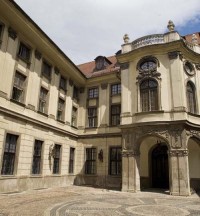TÁROGATÓ, single octave keys, early 20th c., Budapest
Maker’s mark: SCHUNDA V. J. / BUDAPEST
Vencel József SCHUNDA’s factory, see cat. no. 29
In the 18th century, the tárogató was a type of shawm, with a double reed, conical bore, and no keys. The double reed tárogató was an iconic instrument of the Rákóczi’s War for Independence (1703–1711). And its use was suppressed in the 18th century by the Habsburg monarchy. In the 1890s a modern version was invented by Budapest instrument makers, János Stowasser and Vencel József Schunda. They uses a single reed, like a clarinet or saxophone, and has a conical bore, similar to the saxophone. The instrument is made of wood, usually black grenadilla wood like a clarinet.
en

